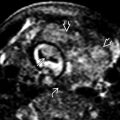KEY FACTS
Terminology
- •
Fetus is pathologically small (growth restricted)
- ○
Fetal growth restriction (FGR)
- ○
Intrauterine growth restriction
- ○
- •
Small for gestational age
- ○
Fetus is small but healthy, not growth restricted
- ○
Imaging
- •
Most common cause of FGR is placental insufficiency
- ○
Estimated fetal weight (EFW) < 5th-10th percentile
- ○
Abdominal circumference (AC) < 5-10 percentile
- ○
Abnormal umbilical artery (UA) Doppler values
- –
Initial ↑ systolic:diastolic (S:D) ratio
- –
Eventual absent end diastolic flow
- –
Final reversed end diastolic flow
- –
- ○
Oligohydramnios
- ○
- •
Other findings with FGR
- ○
Uterine artery postsystolic notch (early finding)
- ○
Ductus venosus shows reversed A-wave (late finding)
- ○
“Brain sparing” physiology (late finding)
- –
Middle cerebral artery S:D ratio < UA S:D ratio
- –
- ○
- •
FGR associations
- ○
Twin-twin transfusion
- ○
Triploidy, trisomy 18, trisomy 13
- ○
Anomalies (such as gastroschisis)
- ○
Clinical Issues
- •
Is pregnancy dated correctly
- ○
Cannot assess growth if dating is incorrect
- ○
- •
FGR fetuses have 4x higher rates of adverse outcome
Scanning Tips
- •
Good AC measurement necessary for accurate EFW
- •
Well-performed biophysical profile testing is key
- ○
Determines risk for fetal acidosis and drives delivery plan
- ○
- •
Perform UA Doppler at midcord level when fetus is at rest

 and occasional reversal of diastolic flow
and occasional reversal of diastolic flow  . High resistive flow in the UA is a hallmark finding with FGR from placental insufficiency. Reversal of flow is associated with a higher incidence of in utero fetal demise.
. High resistive flow in the UA is a hallmark finding with FGR from placental insufficiency. Reversal of flow is associated with a higher incidence of in utero fetal demise.
Stay updated, free articles. Join our Telegram channel

Full access? Get Clinical Tree








